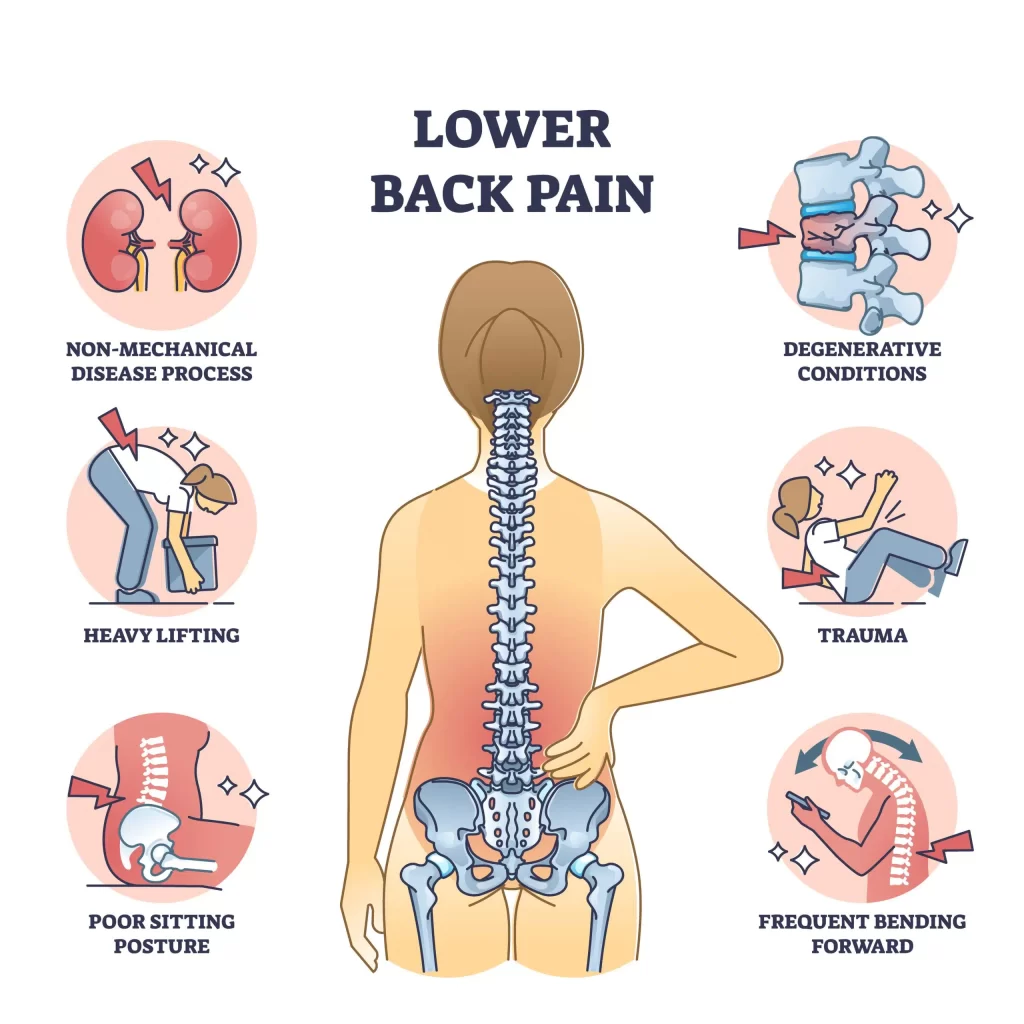One of the most prevalent health problems that people nowadays deal with is lower back discomfort. It can greatly affect day-to-day functioning and range from a subtle discomfort to a searing, incapacitating agony. Let’s examine lower back pain’s causes, signs, available treatments, and practical management techniques.
What is Lower Back Pain?
The term “lower back pain” describes discomfort that arises in the lumbar area, which is the bottom portion of the spine. Any age or degree of exercise can be affected, and it can be either acute (short-term) or chronic (long-lasting).
Common Causes of Lower Back Pain
- Muscle Strain
Lifting heavy objects improperly or sudden awkward movements can strain muscles and ligaments, leading to pain.
- Muscle Strain
- Herniated Discs
Discs act as cushions between the vertebrae. If a disc bulges or ruptures, it can press on nearby nerves, causing pain.
- Herniated Discs
- Arthritis
Osteoarthritis can lead to degenerative changes in the spine, resulting in stiffness and pain.
- Arthritis
- Skeletal Irregularities
Conditions like scoliosis (curvature of the spine) can contribute to back pain.
- Skeletal Irregularities
- Injuries
Falls or sports-related injuries can cause trauma to the back, leading to pain.
- Injuries
- Lifestyle Factors
Poor posture, obesity, and lack of exercise can increase the risk of developing lower back pain.
- Lifestyle Factors
Symptoms of Lower Back Pain
Lower back pain can present itself in various ways:
- Dull Ache or Sharp Pain: The intensity and type of pain can vary.
- Radiating Pain: Pain may extend down to the legs (sciatica) or buttocks.
- Stiffness: Difficulty moving or bending.
- Muscle Spasms: Involuntary contractions can cause discomfort.
- Numbness or Tingling: These sensations may occur in the legs or feet, indicating nerve involvement.

Diagnosis of Lower Back Pain
To determine the cause of lower back pain, healthcare providers may perform:
- Physical Examination: Assessing posture, movement, and reflexes.
- Imaging Tests: X-rays, MRIs, or CT scans to visualize the spine and surrounding structures.
- Blood Tests: To rule out infections or inflammatory conditions.
Treatment Options for Lower Back Pain
1. Medications
- Over-the-Counter Pain Relievers: NSAIDs like ibuprofen or acetaminophen can alleviate pain and reduce inflammation.
- Prescription Medications: Stronger pain relief may be necessary for severe cases.
- Muscle Relaxants: These can help relieve muscle spasms.
2. Physical Therapy
A physical therapist can develop a personalized exercise program to strengthen core muscles, improve flexibility, and alleviate pain.
3. Lifestyle Modifications
- Weight Management: Maintaining a healthy weight can reduce stress on the lower back.
- Posture Improvement: Ergonomic adjustments at work and home can help maintain proper spinal alignment.
4. Alternative Therapies
- Chiropractic Care: Spinal adjustments may provide relief for some individuals.
- Acupuncture: This traditional Chinese medicine technique can help manage pain.
- Massage Therapy: Can relieve tension in the muscles surrounding the spine.
5. Surgery
In rare cases, surgical intervention may be required for severe or persistent lower back pain. Options may include:
- Discectomy: Removal of herniated disc material.
- Laminectomy: Removal of part of the vertebra to relieve pressure on nerves.
- Spinal Fusion: Joining two or more vertebrae to stabilize the spine.
Home Remedies for Lower Back Pain Relief
Several home remedies can help manage lower back pain:
- Heat and Cold Therapy: Applying heat can relax muscles, while cold packs can reduce inflammation.
- Gentle Stretching: Simple stretches can improve flexibility and relieve tension.
- Epsom Salt Baths: Soaking in warm water with Epsom salt can soothe sore muscles.
Preventing Lower Back Pain
While not all cases of lower back pain can be prevented, you can reduce your risk with these strategies:
- Stay Active: Regular physical activity strengthens muscles and supports spinal health.
- Use Proper Lifting Techniques: Bend at the knees, not the waist, when lifting heavy objects.
- Ergonomic Workspace: Ensure your workstation is set up to promote good posture.
Lower back pain is a prevalent issue that can significantly impact daily life. Understanding its causes and implementing effective management strategies can lead to relief and improved quality of life. If you experience persistent or severe pain, don’t hesitate to seek professional medical advice.
FAQs
1. When should I see a doctor for lower back pain?
If the pain lasts longer than a few weeks, is severe, or is accompanied by other symptoms like numbness or bowel/bladder issues, consult a healthcare provider.
2. Can I exercise with lower back pain?
Yes, but it’s essential to choose low-impact activities and consult a healthcare provider or physical therapist for guidance.
3. What role does stress play in lower back pain?
Stress can lead to muscle tension, which may exacerbate back pain. Stress management techniques can be beneficial.
4. Are there any specific stretches that can help?
Gentle stretches like knee-to-chest, cat-cow, and child’s pose can help alleviate tension in the lower back.
5. Is surgery always necessary for lower back pain?
No, most cases can be managed with conservative treatments. Surgery is typically considered a last resort for severe conditions.
